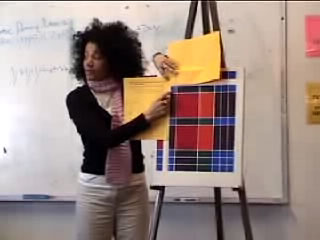Context
Where do I teach?
Content
What are my students learning?
Teaching Practice
What's my approach?
Student Work
Reflections Resources Standards
Archive |
 |
Content
This project demonstrates how I have used Henri Picciotto's
Lab Gear manipulatives to motivate students at Life Learning
Academy to become successful, "hands on," learners
in an algebra class. The project also describes the evolution
of a collaborative interdisciplinary project based on the Lab
Gear manipulatives.
The Colors & Algebra Project provides students
with an opportunity to create a unique representation of their
own understanding of algebra through the use of color mixing
and painting on canvas. Objectives and goals include the following: Students
will be able to a)accurately multiply algebraic expressions,
factor quadratics, and combine like terms b) describe their understanding
of multiplication and factoring by referring to geometric concepts
of dimension and area and c) describe their understanding
of a variable by referring to their experiences with color, shapes,
and materials. Extensive assessment tools and journal prompts
will provided to support implementation.
Expected Student Learning:
Objectives |
Outcomes |
Students will know..... |
Students will be able to ..... |
1. multiplication of algebraic
expressions such as (x + 2) and (y + 3) means that you
are given the dimensions of an area and you are looking
for the area representation |
1.accurately
multiply algebraic expressions and combine like terms.
|
2.
to factor a quadratic such as x²+ 2y + 3x +
6 means that you are given an area of a rectangle and you
are looking for its dimensions |
2. accurately factor a quadratic
with the use of Lab Gear and/or a Generic Rectangle |
3. the properties of
squares and rectangles |
3. use a T-square to
draw parallel and perpendicular lines |
4. the properties of primary
and secondary colors. |
4. create secondary colors
by choosing appropriate paint to mix |
5. the difference between
when variables are multiplied together to create squares
and when they create rectangles. |
6.present their understanding
of multiplication and factoring of algebraic expressions
by referring to geometric concepts of dimension and area. |
6. The sense of a variable
and its relation to the size of their variable shapes. |
6. Choose a size and
make scale drawings to represent their variables. |
7. The definition of
commutative property. |
7. Accurately provide examples
of commutative property by referring to colors, variables,
and constants. |
Project Development History:
I
have used Lab Gear during every year of LLA's existence. Most
of our students arrive to the Academy without a successful career
in mathematics. The Lab Gear provides students with a fresh
start and an opportunity to become "hands-on" learners. For
example, students handle actual squares that represent x² and
y². The geometric perspective of abstract concepts
provides students with a new way into the math.
interview:
Justin Warren |
|
 |
| In this clip, my colleage
Justin, the art and photography teacher at Life Learning
Academy, reflects on his own experience with algebra and
explains how "space and dimension" help students
to conceptualize the process of multiplication whether
it be with numbers and/or variables. |
play
|
Quicktime
Player
high • low
get
plugin |
Windows
Media
high • low
get
plugin |
I had asked my colleague Justin to
cover my class one day when he noticed the student produced posters
hanging on the walls. They
represent factored quadratic equations of the form (Length) (Width)
= Area where blue and yellow colors represent the x variables
and the constants respectively. Days later, as Justin was
sitting across from me in our office he showed me some notes
he had taken that were inspired by the posters. He had
carefully sketched another (L)(W) = Area representation but added
his own idea of color mixing to further explicate the multiplication
of variables. Those notes evolved into the Colors Project
and Robin Havens collaborated with us to enhance the artistic
methods and standards that could be addressed during the project.
The history of the project continues to evolve. During
the second year of the project I will utilize more scaffolding
techniques to support students' understanding of multiplication
of variables. Justin has plans for an extra credit art
project that will address the sense of a variable in another
medium. Robin Havens has researched and provided some insight
into the art standards and the connection to P. Mondrian’s
work.
|
Site last updated
July 5, 2006
|
 The Colors of Algebra
The Colors of Algebra